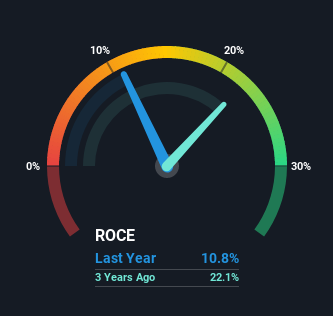Returns On Capital At GMM Pfaudler (NSE:GMMPFAUDLR) Paint A Concerning Picture
If we want to find a potential multi-bagger, often there are underlying trends that can provide clues. Amongst other things, we'll want to see two things; firstly, a growing return on capital employed (ROCE) and secondly, an expansion in the company's amount of capital employed. Ultimately, this demonstrates that it's a business that is reinvesting profits at increasing rates of return. Although, when we looked at GMM Pfaudler (NSE:GMMPFAUDLR), it didn't seem to tick all of these boxes.
Return On Capital Employed (ROCE): What is it?
If you haven't worked with ROCE before, it measures the 'return' (pre-tax profit) a company generates from capital employed in its business. To calculate this metric for GMM Pfaudler, this is the formula:
Return on Capital Employed = Earnings Before Interest and Tax (EBIT) ÷ (Total Assets - Current Liabilities)
0.11 = ₹1.8b ÷ (₹25b - ₹8.9b) (Based on the trailing twelve months to September 2021).
Thus, GMM Pfaudler has an ROCE of 11%. In absolute terms, that's a pretty standard return but compared to the Machinery industry average it falls behind.
View our latest analysis for GMM Pfaudler

In the above chart we have measured GMM Pfaudler's prior ROCE against its prior performance, but the future is arguably more important. If you'd like to see what analysts are forecasting going forward, you should check out our free report for GMM Pfaudler.
So How Is GMM Pfaudler's ROCE Trending?
On the surface, the trend of ROCE at GMM Pfaudler doesn't inspire confidence. Around five years ago the returns on capital were 18%, but since then they've fallen to 11%. Although, given both revenue and the amount of assets employed in the business have increased, it could suggest the company is investing in growth, and the extra capital has led to a short-term reduction in ROCE. And if the increased capital generates additional returns, the business, and thus shareholders, will benefit in the long run.
The Key Takeaway
In summary, despite lower returns in the short term, we're encouraged to see that GMM Pfaudler is reinvesting for growth and has higher sales as a result. And long term investors must be optimistic going forward because the stock has returned a huge 311% to shareholders in the last three years. So while investors seem to be recognizing these promising trends, we would look further into this stock to make sure the other metrics justify the positive view.
One more thing to note, we've identified 3 warning signs with GMM Pfaudler and understanding these should be part of your investment process.
While GMM Pfaudler may not currently earn the highest returns, we've compiled a list of companies that currently earn more than 25% return on equity. Check out this free list here.
New: Manage All Your Stock Portfolios in One Place
We've created the ultimate portfolio companion for stock investors, and it's free.
• Connect an unlimited number of Portfolios and see your total in one currency
• Be alerted to new Warning Signs or Risks via email or mobile
• Track the Fair Value of your stocks
This article by Simply Wall St is general in nature. We provide commentary based on historical data and analyst forecasts only using an unbiased methodology and our articles are not intended to be financial advice. It does not constitute a recommendation to buy or sell any stock, and does not take account of your objectives, or your financial situation. We aim to bring you long-term focused analysis driven by fundamental data. Note that our analysis may not factor in the latest price-sensitive company announcements or qualitative material. Simply Wall St has no position in any stocks mentioned.
Have feedback on this article? Concerned about the content? Get in touch with us directly. Alternatively, email editorial-team (at) simplywallst.com.
About NSEI:GMMPFAUDLR
GMM Pfaudler
Designs, manufactures, installs, and services corrosion-resistant equipment and complete chemical process systems used in the chemical, pharmaceutical, and other industries in India and internationally.
Excellent balance sheet average dividend payer.
Similar Companies
Market Insights
Community Narratives


